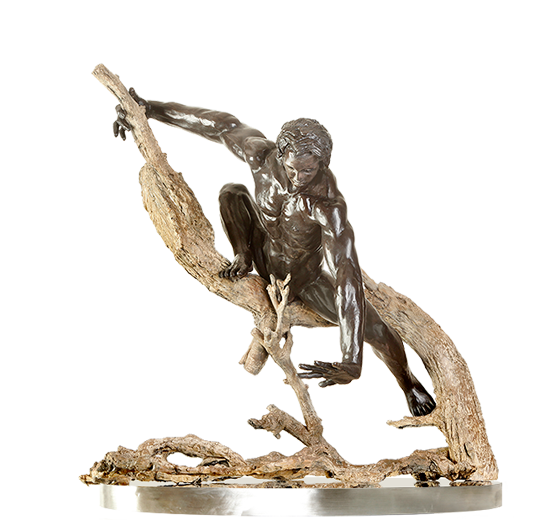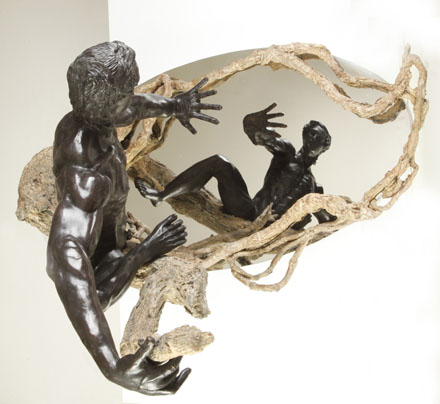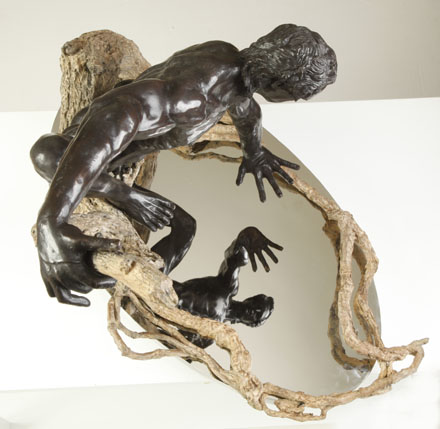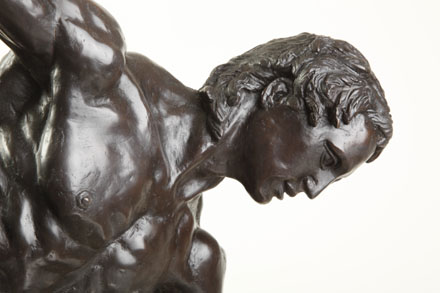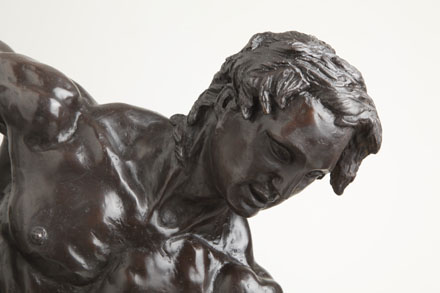 home
about
artists
exhibitions
press
contact
purchase
home
about
artists
exhibitions
press
contact
purchase |
|||||||
|
RICHARD L. MINNS Table
top-to-medium-size bronze CLASSICAL
MYTHOLOGY: The Greek gods turned the dead Narcissus into the Narcissus flower / plant which grows on the edge of the pond and bends to the water, which fully reflects the plant. In psychology, Narcissus is the origin of the term “Narcissism”, a fixation with oneself. ARTIST’S
INTERPRETATION “Holding the tree with his right arm, he stretches his left arm down to the water, fingers spread wide, so he can also see the reflection of his hand. Narcissus is reflected fully in the polished stainless steel pond, which acts as a mirror.” “The sculpture is designed so that at first glance the viewer sees Narcissus’ beautiful body, but only the top of his head. The viewer must look at the pond below Narcissus in order to see Narcissus’ face. The viewer sees what Narcissus sees.” “I hope that you enjoy Narcissus half as much as I have enjoyed creating him.”
DESCRIPTION OF SCULPTURE 1. Psychology. Origin of the term “Narcissism”, a fixation with oneself. 2. Art. The myth of Narcissus has inspired artists for at least two thousand years, even before the Roman poet Ovid featured a version in Book III of his “Metamorphoses”. 3. Literature – Too numerous to list. Includes Oscar Wilde’s “The Picture of Dorian Gray”, Herman Melville’s “Moby Dick” and William Faulkner’s character “Narcissa” in “Sanctuary”. Richard’s Narcissus is an anatomically perfect youth, athletic, physically beautiful. But, as Richard says: “more of an Apollo than a Hercules”, inspired by Michelangelo’s “David” and Rodin’s “Adam”. Narcissus’ outstretched long fingers are a bit of an inspiration of Egon Schiele. Narcissus is modeled in Rodin-style, and the patination is strictly Rodin, with a brown undercoating first baked into the metal and then covered by a rich black so when the light dances on Narcissus, the brown undercoating shines through subtly, but brilliantly. The tree and supporting vines which circle the lake is a combination of Richard’s unique skills and Mother Nature. Richard went on a hunting expedition in the forest to find the tree limbs and the vines with the exact texture he wanted. Then he made a mold of the tree limbs and the vines and turned them into a wax which he could bend and mold to meet the desired position and effect. A special patina made the bronze tree and vines come alive. The polished stainless steel base acts as a reflection pool, reflecting Narcissus’ face, body and outstretched hand. The only way the viewer can get a full view of Narcissus’ face is to look at his reflection of the pool below.Richard Minns
|
|||||||
|
|
|||||||
